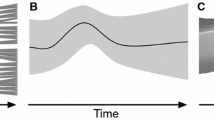Abstract
In the usual description of space and time, particles are represented by continuous world lines. We replace these world lines by discrete rows of points, obtaining a locally finite, partially ordered set. The “distances” between points along these discrete world lines, and also the “distances” between different world lines, are measured not simply as the distances within the space-time manifold in which the partially ordered set happens to be embedded, but rather in terms of the partially ordered set itself. It is found that variations in the density of points of the partially ordered set produce corresponding variations in the scale of “distances” within the set. These variations produce a gravitational effect which is similar to that of the general theory of relativity.
Similar content being viewed by others
References
F. Hoyle and J. V. Narlikar, Action at a distance in physics and cosmology (W. H. Freeman and Company, 1974).
J. V. Narlikar, Proc. Camb. Phil. Soc. 64, 1071 (1968).
H. Yilmaz, Introduction to the theory of relativity and the principles of modern physics (Blaisdell Publishing Company, 1965).
Author information
Authors and Affiliations
Rights and permissions
About this article
Cite this article
Hemion, G. A quantum theory of space and time. Found Phys 10, 819–840 (1980). https://doi.org/10.1007/BF00708682
Received:
Issue Date:
DOI: https://doi.org/10.1007/BF00708682



